Discover 35 hidden attractions, cool sights, and unusual things to do in Cologne (Germany). Don't miss out on these must-see attractions: Cologne Cathedral, Schokoladenmuseum, and Hohe Straße. Also, be sure to include Kölner Zoo in your itinerary.
Below, you can find the list of the most amazing places you should visit in Cologne (North Rhine-Westphalia).
Table of Contents
Cologne Cathedral
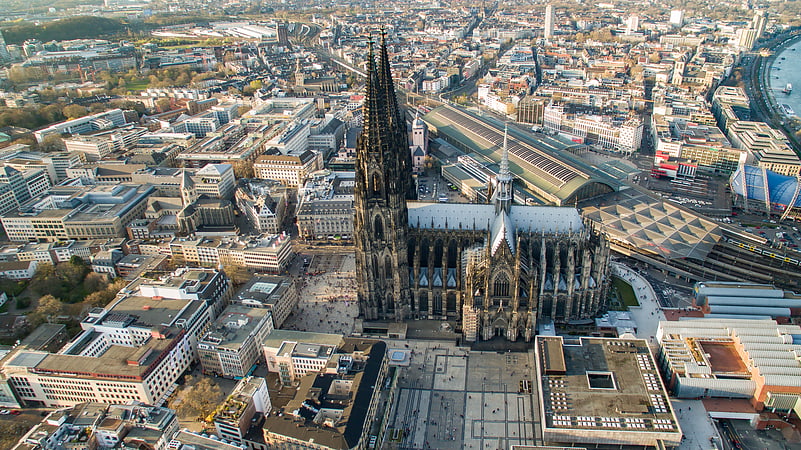
Also known as: Kölner Dom
Grand Gothic cathedral with twin spires. Cologne Cathedral is a Catholic cathedral in Cologne, North Rhine-Westphalia. It is the seat of the Archbishop of Cologne and of the administration of the Archdiocese of Cologne. It is a renowned monument of German Catholicism and Gothic architecture and was declared a World Heritage Site in 1996. It is Germany's most visited landmark, attracting an average of 20,000 people a day. At 157 m, the cathedral is currently the tallest twin-spired church in the world, the second tallest church in Europe after Ulm Minster, and the third tallest church in the world. It is the largest Gothic church in Northern Europe and has the second-tallest spires. The towers for its two huge spires give the cathedral the largest façade of any church in the world. The choir has the largest height-to-width ratio, 3.6:1, of any medieval church.
Construction of Cologne Cathedral began in 1248 but was halted in the years around 1560, unfinished. Work did not restart until the 1840s, and the edifice was completed to its original Medieval plan in 1880.
Cologne's medieval builders had planned a grand structure to house the reliquary of the Three Kings and fit its role as a place of worship for the Holy Roman Emperor. Despite having been left incomplete during the medieval period, Cologne Cathedral eventually became unified as "a masterpiece of exceptional intrinsic value" and "a powerful testimony to the strength and persistence of Christian belief in medieval and modern Europe". Only the telecommunications tower is higher than the Cathedral.[1]
Address: Domkloster 4, 50667 Cologne (Innenstadt)
Schokoladenmuseum
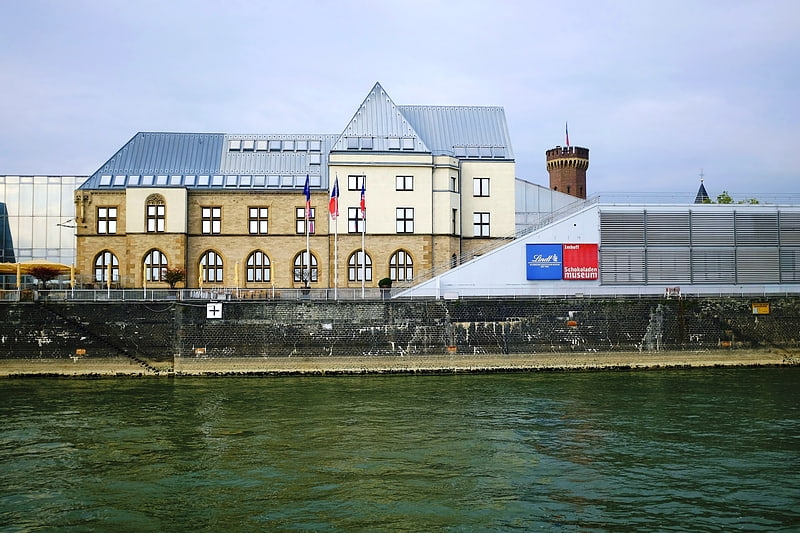
Waterside museum devoted to chocolate. The Imhoff-Schokoladenmuseum was opened by Hans Imhoff on 31 October 1993. It is situated in the Cologne quarter of Altstadt-Süd on the Rheinauhafen peninsula. The exhibits show the entire history of chocolate, from its beginnings with the Olmecs, Maya and Aztecs to contemporary products and production methods.
With 5,000 guided tours and 675,000 visitors a year, the museum is in the Top Ten of German museums. The museum is entirely self-supporting, receiving no subsidy. It has its own marketing department and is used by the Schokoladenmuseum Gastronomie GmbH for events.[2]
Address: Am Schokoladenmuseum 1A, 50678 Köln (Innenstadt)
Hohe Straße
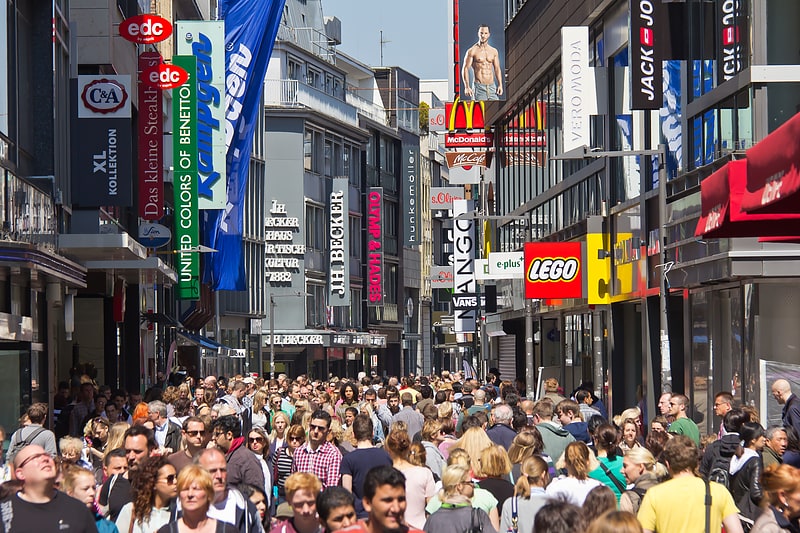
Street in Cologne, Germany. Hohe Straße is a shopping street in the old town of Cologne, Germany, and one of the city's both oldest and busiest streets. Together with many of its adjacent side streets, Hohe Straße is part of a designated pedestrian zone and spans about 680 metres from Cologne Cathedral on its Northern end to Schildergasse on its Southern end.[3]
Address: Hohe Str., 50667 Köln (Innenstadt)
Kölner Zoo
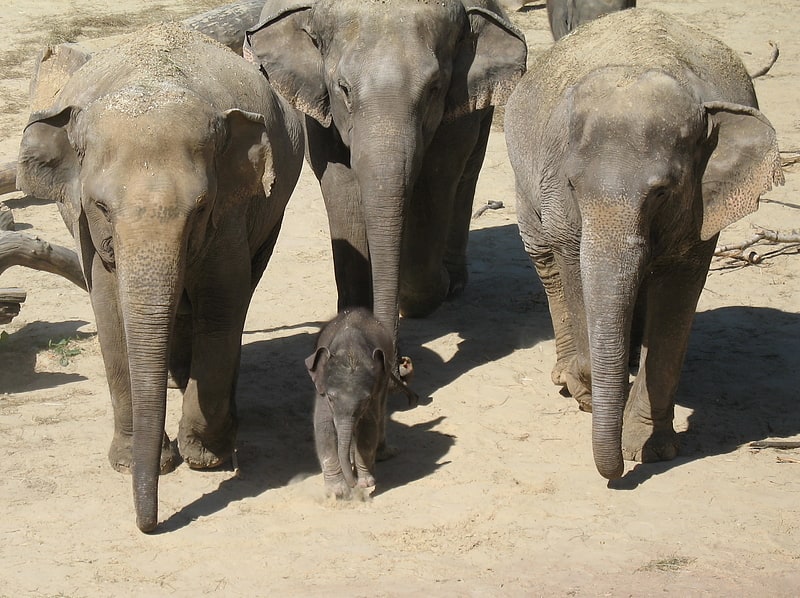
Zoo with elephant park and jungle house. The Aktiengesellschaft Cologne Zoological Garden is the zoo of Cologne, Germany. It features over 10,000 animals of more than 850 species on more than 20 hectares. The internationally renowned zoo with an attached aquarium and invertebrate exhibit is active in preservational breeding of animals that are in danger of becoming extinct. In addition, in-the-wild conservation efforts and research focussing on animals of Madagascar, Wallacea, and Vietnam are actively promoted and supported via cooperation with Cologne University and local projects, such as in the case of Przewalski's horses.
The zoo was founded in 1860. The world wars led to a phase of stagnation, and the zoo had to close for two years entirely, after virtually being destroyed in World War II. It reopened in 1947; the aquarium was added in 1971. In 1985, the large primate house, one of the main attractions, was opened. Today, the zoo also features a free-flight rainforest hall with free-ranging birds and reptiles opened in 2000, a large elephant park, a house for hippos with great underwater views, and as the latest addition, a farm with rare native species and petting zoo.[4]
Address: Riehler Str. 173, 50735 Köln (Nippes)
Cologne Cathedral Window

The Cologne Cathedral Window is the stained glass window in the south transept of the Cologne Cathedral designed by Cologne artist Gerhard Richter. On a surface of 106 square metres 11.263 glass squares in 72 colours of 9,6 cm × 9.6 cm were principally arranged randomly, with others selected in response to architectural context. The window was inaugurated on August 25, 2007 as part of a Eucharistic celebration; the abstract execution was both celebrated and strongly criticized.[5]
Museum Ludwig
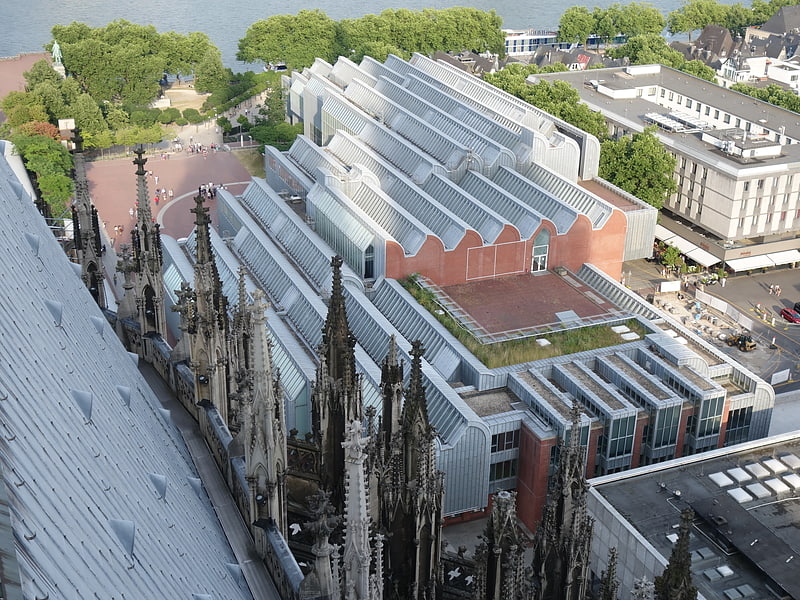
Extensive collection of Picasso works. Museum Ludwig, located in Cologne, Germany, houses a collection of modern art. It includes works from Pop Art, Abstract and Surrealism, and has one of the largest Picasso collections in Europe. It holds many works by Andy Warhol and Roy Lichtenstein.[6]
Address: Bischofsgartenstr. 1, 50667 Cologne (Innenstadt)
Hohenzollern Bridge
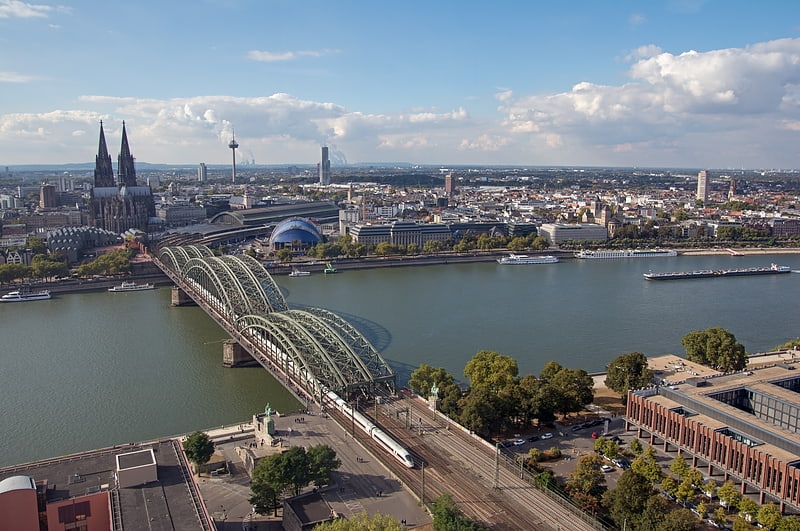
Also known as: Hohenzollernbrücke
Arch bridge in Cologne, Germany. The Hohenzollern Bridge is a bridge crossing the river Rhine in the German city of Cologne. It crosses the Rhine at kilometre 688.5. Originally, the bridge was both a railway and road bridge. However, after its destruction in 1945 and its subsequent reconstruction, it was only accessible to rail and pedestrian traffic.
It is the most heavily used railway bridge in Germany with more than 1,200 trains daily, connecting the Köln Hauptbahnhof and Köln Messe/Deutz stations.[7]
Address: Kennedy-Ufer 2a, 50679 Cologne (Innenstadt)
Cologne Central Mosque
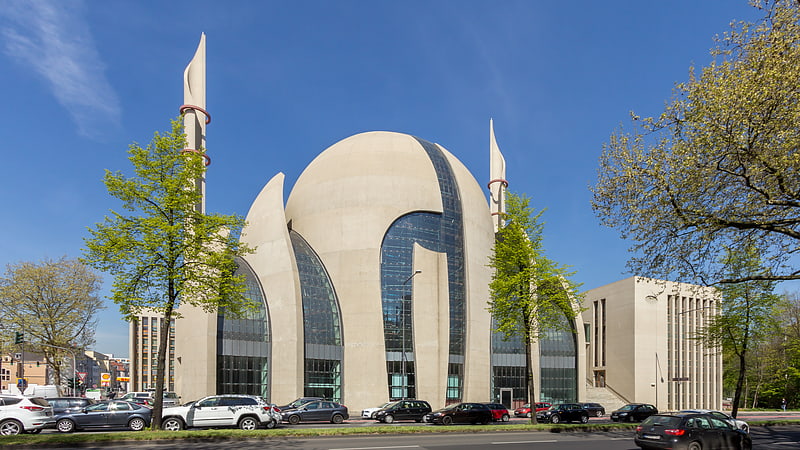
The Cologne Central Mosque is a building commissioned by German Muslims of the Organization DITIB for a large, representative Zentralmoschee in Cologne, Germany. This mosque was inaugurated by Turkish President Erdogan. After controversy, the project won the approval of Cologne's city council.
The mosque is designed in neo-Ottoman architectural style, with glass walls, two minarets and a dome. The mosque is proposed to have a bazaar as well as other secular areas intended for interfaith interactions. As the mosque will be one of Europe's biggest mosques, and the largest mosque in Germany, it has been criticized by some, particularly for the height of the minarets.[8]
Address: 160 Venloer Straße, Cologne (Ehrenfeld)
Melaten Cemetery
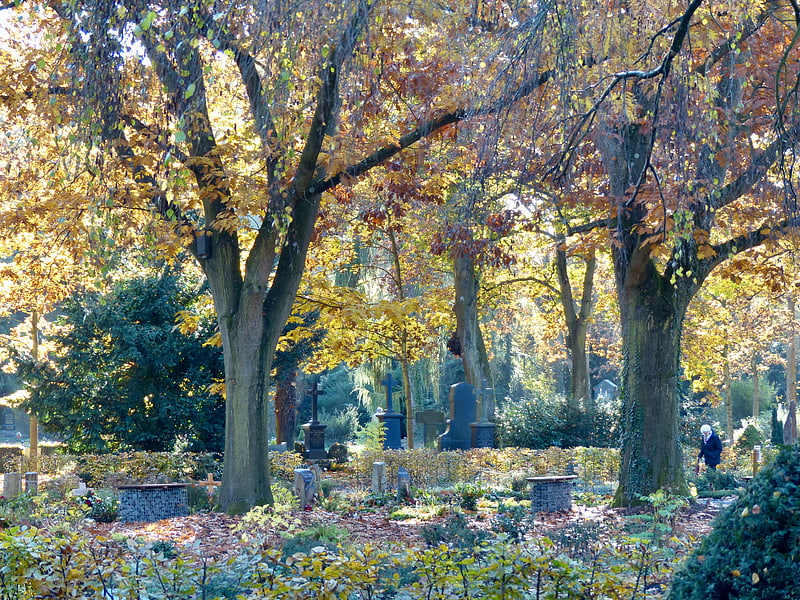
Also known as: Melaten-Friedhof
Cemetery in Cologne, Germany. Melaten is the central cemetery of Cologne, North Rhine-Westphalia, which was first mentioned in 1243. It was developed to a large park, holding the graves of notable residents.[9]
Address: Aachener Straße 204, Cologne (Lindenthal)
Memorial to gay and lesbian victims of National Socialism
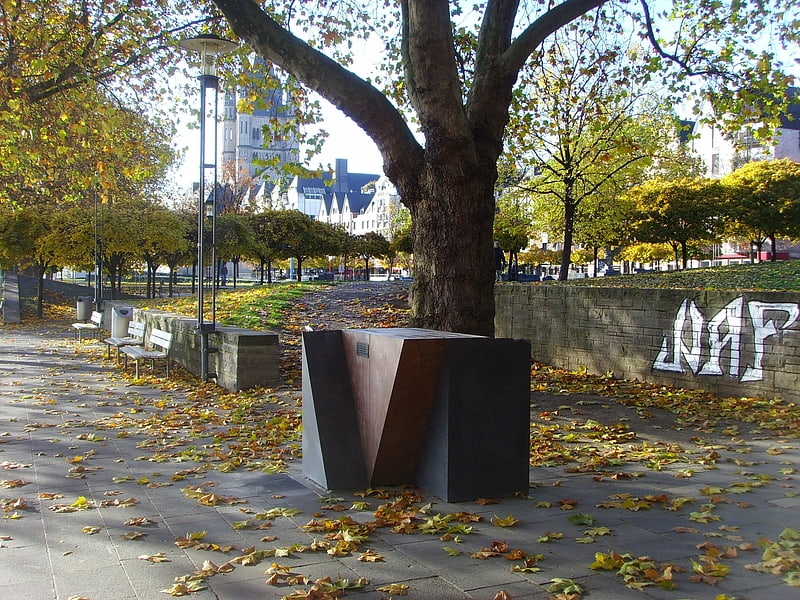
Also known as: Mahnmal für die schwulen und lesbischen Opfer des Nationalsozialismus in Köln
The memorial to gay and lesbian victims of National Socialism is a monument in Cologne, Germany, dedicated to the gay and lesbian victims of the Nazis.
The memorial, dedicated on 24 June 1995, is located next to the Hohenzollern Bridge, on the bank of the Rhine. The site was chosen for its historical significance: Traditionally, the bridge was a popular meeting place for gay men who wanted to have anonymous sexual contacts.[10]
Museum of East Asian Art
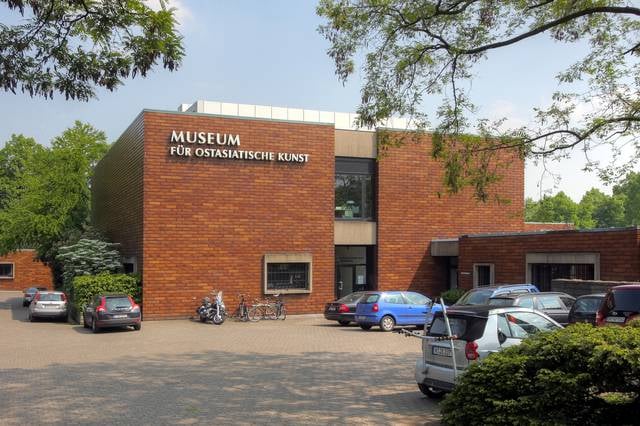
Museum in Cologne, Germany. The Museum of East Asian Art opened in Cologne, Germany in 1913 and is the oldest of its kind in the country. The collection of Chinese, Korean, and Japanese art originates in that of its founders Adolf Fischer and his wife Frieda. The new building by architect Kunio Maekawa, pupil of Le Corbusier, opened in 1977.[11]
Address: Universitätsstraße 100, 50674 Köln (Innenstadt)
Käthe Kollwitz Museum
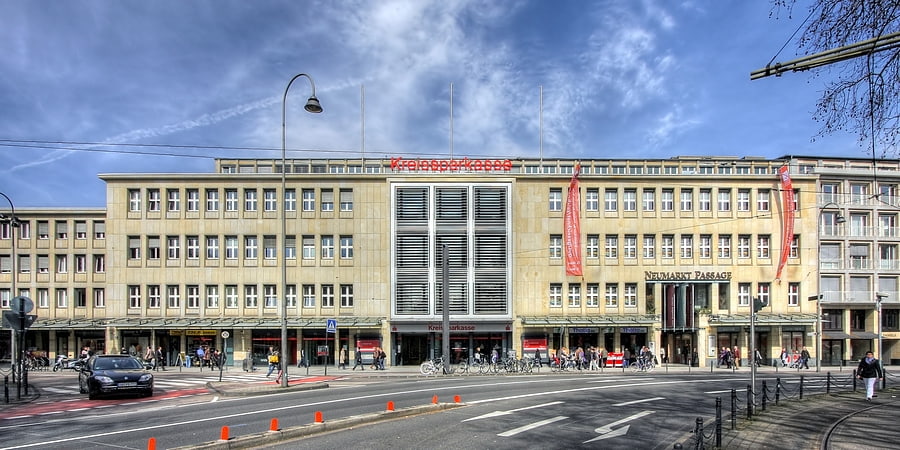
Showcase of artist Kollwitz's work. The Käthe Kollwitz Museum in Cologne owns the largest collections of works by the German artist Käthe Kollwitz and has maintained close links with the Kollwitz family. The museum is owned and operated by the Kreissparkasse Köln savings bank.[12]
Address: Neumarkt 18-24, 50667 Köln (Innenstadt)
Römisch-Germanisches Museum
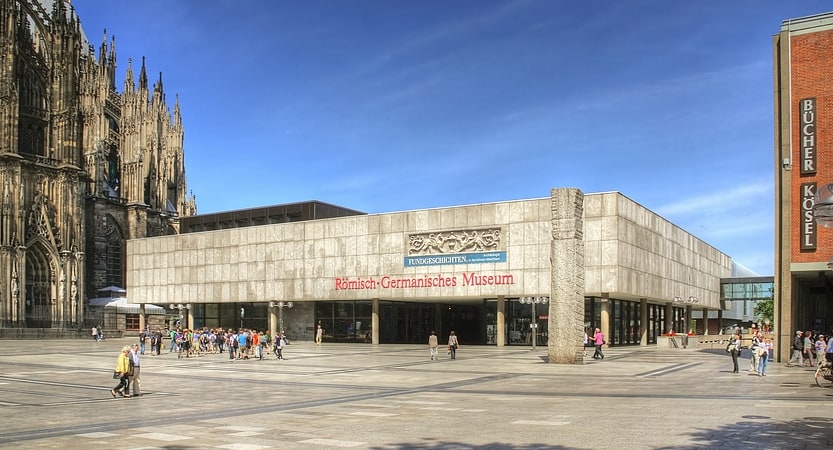
Museum for Roman artifacts and antiquities. The Roman-Germanic Museum is an archaeological museum in Cologne, Germany. It has a large collection of Roman artifacts from the Roman settlement of Colonia Claudia Ara Agrippinensium, on which modern Cologne is built. The museum protects the original site of a Roman town villa, from which a large Dionysus mosaic remains in its original place in the basement, and the related Roman Road just outside. In this respect the museum is an archaeological site.
The museum also has the task of preserving the Roman cultural heritage of Cologne, and therefore houses an extensive collection of Roman glass from funerals and burials and also exercises archaeological supervision over the construction of the Cologne underground.
Most of the museum's collection was housed at the Wallraf-Richartz Museum in Cologne until 1946. In the front of the museum the former northern town gate of Cologne with the inscription CCAA (for Colonia Claudia Ara Agrippinensium) is on display in the building.[13]
Address: Roncalliplatz 4, 50667 Köln (Innenstadt)
Wallraf-Richartz Museum
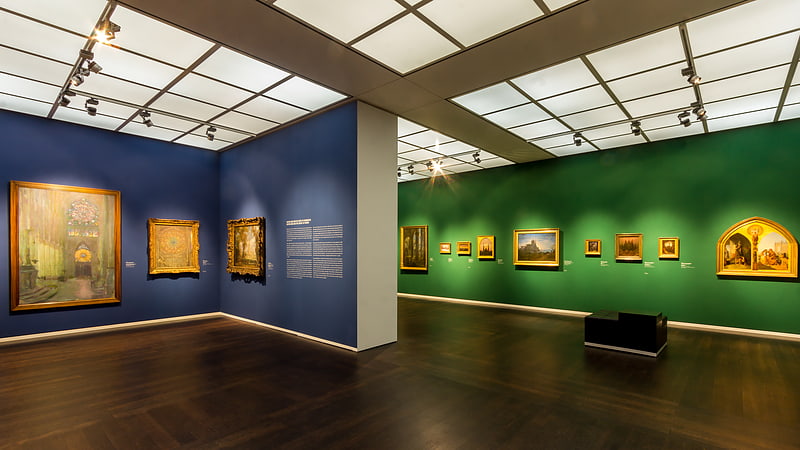
Also known as: Wallraf-Richartz-Museum & Fondation Corboud
Fine art from 14th to early 20th century. The Wallraf–Richartz Museum is one of the three major museums in Cologne, Germany. It houses an art gallery with a collection of fine art from the medieval period to the early twentieth century.[14]
Address: Obenmarspforten 40, 50667 Köln (Innenstadt)
Flora Botanical Garden
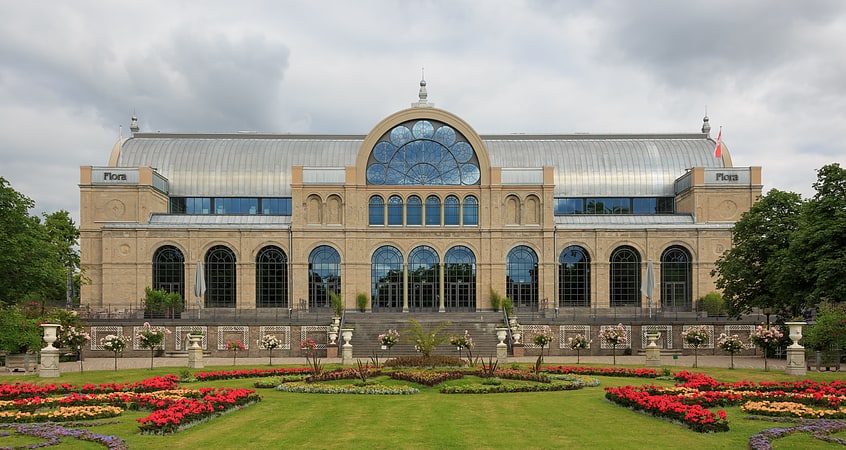
Also known as: Flora
Unique plants from all over the world. The Flora und Botanischer Garten Köln is a municipal formal park and botanical garden located adjacent to Cologne Zoological Garden at Amsterdamer Straße 34, Cologne, North Rhine-Westphalia, Germany. It is open daily without charge.
The garden dates to 1863 when a private company was organized to create Flora park (5.5 hectares) as a replacement for the city's older botanical garden near the Cologne Cathedral, which in 1857 was destroyed for construction of the central railway station. This new park was designed by Peter Joseph Lenné in 1864 in a mixed German style, incorporating French Baroque, Italian Renaissance, and English landscape garden elements. In its center is a glass palace (orangery) structure of cast iron and glass patterned upon the Crystal Palace (London) and Jardin d'hiver (Paris), which served as an exhibition site through the late 19th century, including horticultural exhibitions in 1875 and 1888, and an industrial exhibition in 1889. Frauen-Rosenhof, an art nouveau garden, was added in 1906.
Between 1912 and 1914, as it suffered financial problems, the garden was acquired by the city, which in 1914 built an adjacent botanical garden (4.5 hectares). These two gardens were united in 1920, with new glasshouses and exhibition houses for exotic and tropical plants added in the 1950s.
Flora park was restored in 1987, and today contains an Italian Renaissance garden with hornbeam pergolas, cascade, and the (since a couple of years restored) Flora Temple, surrounded by gardens in the English landscape style, as well as a heather garden, fern garden, fragrance garden, Mediterranean garden, and pond. It also contains a number of notable trees, some dating to the garden's establishment; more than 60 specimens have been designated natural monuments.
The botanical garden cultivates nearly 10,000 types of plants, including approximately 2000 species in its alpine garden. It also contains good collections of magnolias, rhododendrons, coniferous trees, maples, and Hamamelidaceae, as well as a medicinal plant garden and farmer's garden of local crops. About 5,000 species are presented in four exhibition greenhouses:
- Main greenhouse – tropical rainforest plants.
- Small tropical house – tropical crops including bamboo, cinnamon, cocoa, coconut palm, coffee, pineapple, sugar cane, and vanilla, plus water and marsh plants including rice, taro, lotus, and water lilies.
- Subtropical house (opened 1964) – subtropical plants from the Americas, Africa, Asia, and Australia, including camellias, proteas, and tree ferns.
- Cactus house – cacti and succulents from the world's deserts and semi-deserts.
Address: Amsterdamer Strasse 34, 50735 Cologne (Nippes)
Great St. Martin Church

Also known as: Groß St. Martin
Romanesque church with iconic tower. The Great Saint Martin Church is a Romanesque Catholic church in Cologne, Germany. Its foundations rest on remnants of a Roman chapel, built on what was then an island in the Rhine. The church was later transformed into a Benedictine monastery. The current buildings, including a soaring crossing tower that is a landmark of Cologne's Old Town, were erected between 1150-1250. The architecture of its eastern end forms a triconch or trefoil plan, consisting of three apses around the crossing, similar to that at St. Maria im Kapitol. The church was badly damaged in World War II; restoration work was completed in 1985.
As of 2009 Great Saint Martin is being used by a branch of the Monastic Fraternities of Jerusalem and is open for visits again.[16]
Address: An Groß St. Martin 9-11, 50667 Köln (Innenstadt)
Antoniterkirche
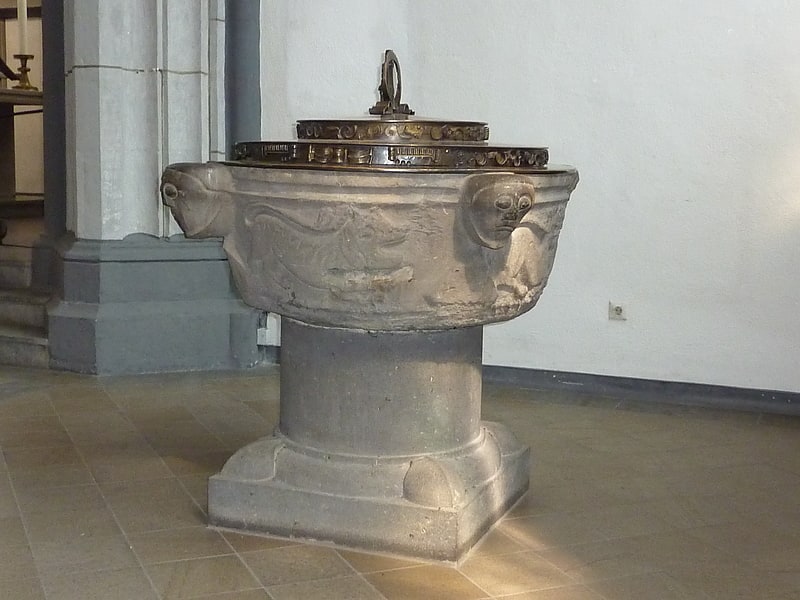
Church building in Cologne, Germany. The Antoniterkirche is a Gothic church building on the Schildergasse in central Cologne, Germany, named after the Hospital Brothers of St. Anthony who founded it between 1350 and 1370–1378. Now used by the Protestant Church, it is the second most-visited church in the city after Cologne Cathedral. The Resistance fighter Freya von Moltke was baptised there.
It has become known throughout Germany as the venue for the 'Politisches Nachtgebet' (with the likes of Dorothee Sölle) and the site of Ernst Barlach's artwork Der Schwebende, also known as Angel, als well as Kruzifix II and Der Lehrende. Since 2016 it has been a member of the Coventry Cross of Nails.[17]
Address: 57 Schildergasse, Cologne (Innenstadt)
Kolumba
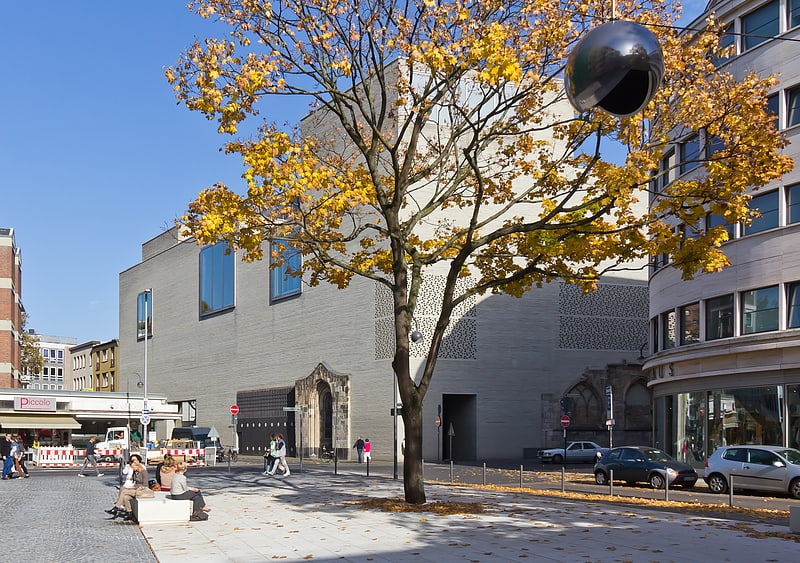
Contemporary museum with religious art. The Kolumba is an art museum in Cologne, Germany. It is located on the site of the former St. Kolumba church, and run by the Archdiocese of Cologne. It is one of the oldest museums in the city, alongside the Wallraf-Richartz Museum.[18]
Address: Kolumbastraße 4, 50667 Köln (Innenstadt)
Shrine of the Three Kings

Also known as: Dreikönigenschrein
Ornate shrine for the Three Kings' bones. The Shrine of the Three Kings, Tomb of the Three Kings, or Tomb of the Three Magi is a reliquary traditionally believed to contain the bones of the Biblical Magi, also known as the Three Kings or the Three Wise Men. The shrine is a large gilded and decorated triple sarcophagus placed above and behind the high altar of Cologne Cathedral in western Germany. Built approximately from 1180 to 1225, it is considered the high point of Mosan art and the largest reliquary in the Western world.[19]
Minoritenkirche

Catholic church in Cologne, Germany. The Minoritenkirche or Church of the Immaculate Conception is a Catholic church on the Kolpingplatz in Cologne. Built in the 13th century, it is now used by the Franciscan and the Kolpingwerk social association.
It is notable for containing the tombs of Duns Scotus and Adolph Kolping, both of whom were beatified by Pope John Paul II - Kolping was also ordained priest in the church. Kolping and Scotus both feature on the new west doors designed by Paul Nagel in 2006.[20]
Address: 2 Kolpingplatz, Cologne (Innenstadt)
Rheinpark

Landscaped park with cable-car and tours. The Rheinpark is a 40 hectare large urban park along the right bank of the river Rhine in Cologne, Germany. The park lies between the Cologne districts of Deutz and Mülheim and includes a beach club, an open-air theater and a Roman Thermae styled public bath. It has been voted Germany's best park in 2007.[21]
Address: Rheinparkweg 1, 50679 Köln (Innenstadt)
RheinEnergieStadion
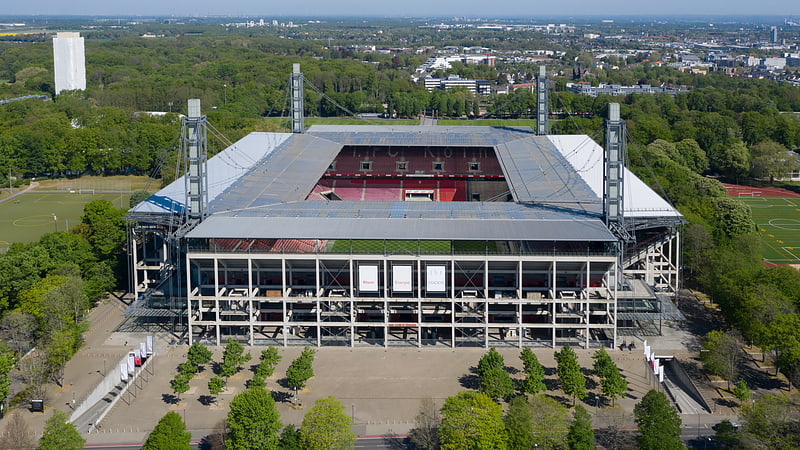
Also known as: Rheinenergiestadion
Stadium in Cologne, Germany. RheinEnergieStadion, formerly Müngersdorfer Stadion or Müngersdorfer Stadium, is a German football stadium in Cologne. It was built on the site of the two previous Müngersdorfer stadiums. It is the home of the local Bundesliga team, 1. FC Köln. The stadium was one of five stadiums hosting both the 2005 FIFA Confederations Cup and 2006 FIFA World Cup, and hosted the 2020 UEFA Europa League Final behind closed doors. Local energy company RheinEnergie AG currently holds the naming rights to the stadium, hence it was known as the Stadion Köln for the final.[22]
Address: Cologne, Aachener Straße 999, 50933 Cologne, Germany
Historical Archive of the City of Cologne
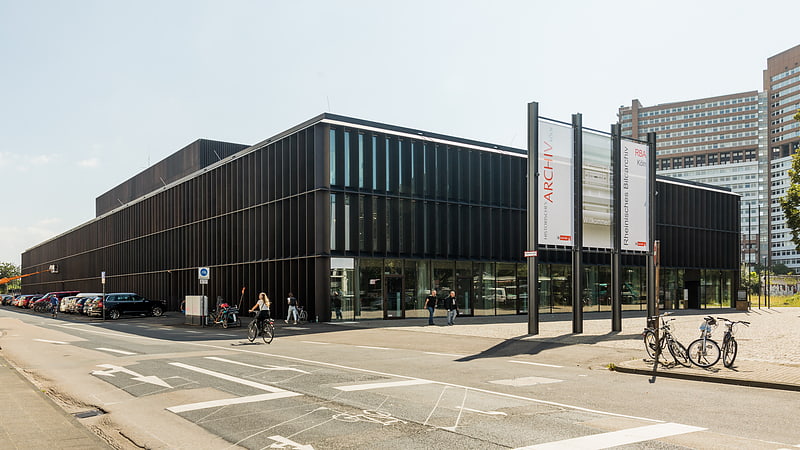
Also known as: Historisches Archiv der Stadt Köln
City government office in Cologne, Germany. The Historical Archive of the City of Cologne is the municipal archive of Cologne, Germany. It ranks among the largest communal archives in Europe.
A municipal archive has existed in Cologne since the Middle Ages. The oldest inventory of charters in the archive is dated 1408/1409. The oldest document kept in the archive is a charter dated AD 922.
The archive contains official records and private documents from all ages of Cologne history, as well as an extensive library of manuscripts. While the adjective "historical" in its name might suggest a closed, complete archive with a focus on older history, the archive is also the official government repository responsible for collecting recent municipal records.
The six-story archive building collapsed on 3 March 2009, along with two neighboring apartment buildings. Two residents of neighboring buildings were found dead. All archive staff and visiting archive users survived, as they were able to escape following a warning by construction workers. Around 90% of archival records were buried by the collapse, although it subsequently proved possible to rescue and repair many of them.
Construction work on a new archive began in 2016, and the new archive opened on 3 September 2021. At that time, a spokesperson for the Archive estimated that restoration work will require more than 200 persons' continuous effort for thirty years.[23]
St. Kolumba
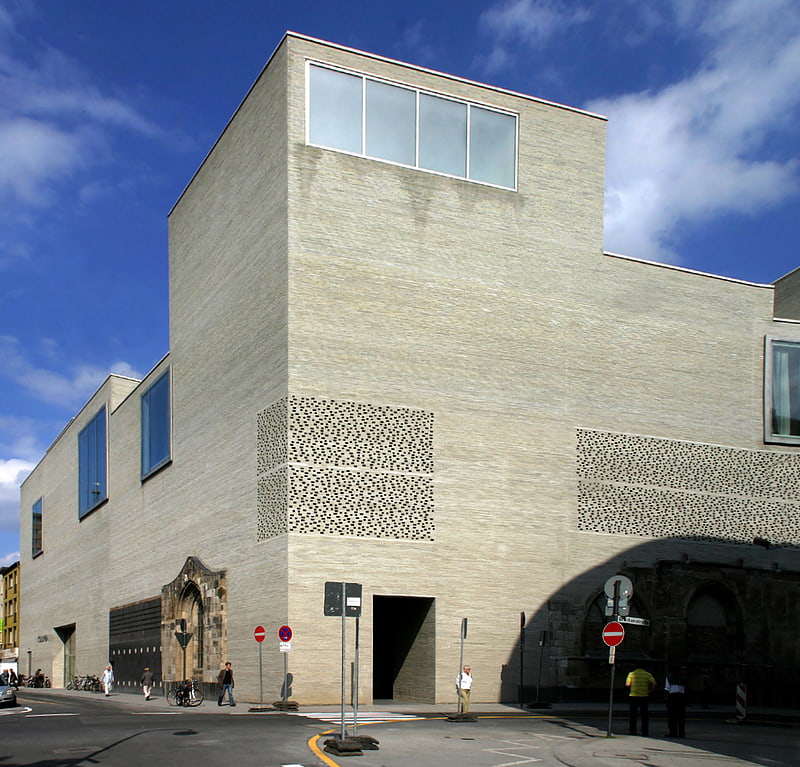
Chapel in Cologne, Germany. St. Kolumba was one of the largest parish churches in medieval Cologne, dating back to 980, and dedicated to Columba of Sens. The original Romanesque church was replaced by a Gothic church. Artworks in it included the Saint Columba Altarpiece by Rogier van der Weyden, and an altar by an anonymous artist.
It was almost completely destroyed by bombing in World War II. From 1947, a chapel was built on the ruins, dedicated to Mary as "Madonna of the Ruins". The chapel was called St. Kolumba from 2007, when it became part of the Kolumba, the museum of the archdiocese of Cologne.[24]
Skulpturenpark

Leafy park with contemporary sculptures. Skulpturen Park Köln is a major international overview of contemporary sculpture which has been on display to the public, in a series of two-year exhibitions, in Cologne, Germany, since 1997.[25]
Address: Elsa-Braendstroem-Str. 9, 50668 Cologne (Innenstadt)
St. Andrew's Church

Also known as: St. Andreas
Romanesque church from the 10th century. St. Andrew's is a 10th-century Romanesque church located in the old town of Cologne, Germany. It is one of twelve churches built in Cologne in that period. Archbishop Gero consecrated the church in 974, dedicating it to St. Andrew, although an earlier church at the site was dedicated to St. Matthew. In the 12th century, the church was rebuilt in the Romanesque style, and was probably completed after the great fire of Cologne in 1220. In the crypt of the church lies a Roman sarcophagus from the 3rd century, which holds the remains of the 13th-century theologian and natural philosopher St. Albertus Magnus. Since 1947, the Dominican Order has ministered to the church.[26]
Address: Komödienstraße 6-8, 50667 Köln (Innenstadt)
St. Gereon's Basilica
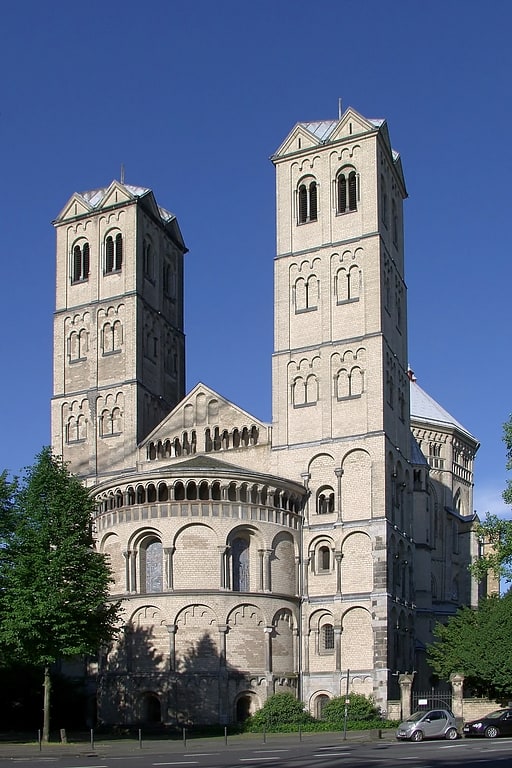
Also known as: St. Gereon
Romanesque church with a 10-sided dome. St. Gereon's Basilica is a German Roman Catholic church in Cologne, dedicated to Saint Gereon, and designated a minor basilica on 25 June 1920. The first mention of a church at the site, dedicated to St. Gereon, appears in 612. However, the building of the current choir gallery, apse, and transepts occurred later, beginning under Archbishop Arnold II von Wied in 1151 and ending in 1227. It is one of twelve great churches in Cologne that were built in the Romanesque style.
St. Gereon has a highly irregular plan, the nave being covered by a decagonal oval dome, 21.0 m long and 16.9 m wide, completed in 1227 on the remains of Roman walls, which are still visible. It is the largest dome built in the West between the erection of the Hagia Sophia in the 6th century and the Duomo of Florence in the 15th century.
Ernst Seifert built an organ there in 1898. In the 20th century, the architect Andreas Dilthey worked on its interior.
Archaeological excavation has revealed the presence of an earlier structure from the fourth century, possibly a funerary building that was converted into a church by the sixth century. This original church was perhaps called the church of the Golden Saints (ad sanctos aureos) by Gregory of Tours.[27]
Address: Gereonshof 2, 50670 Köln (Innenstadt)
Musical Dome
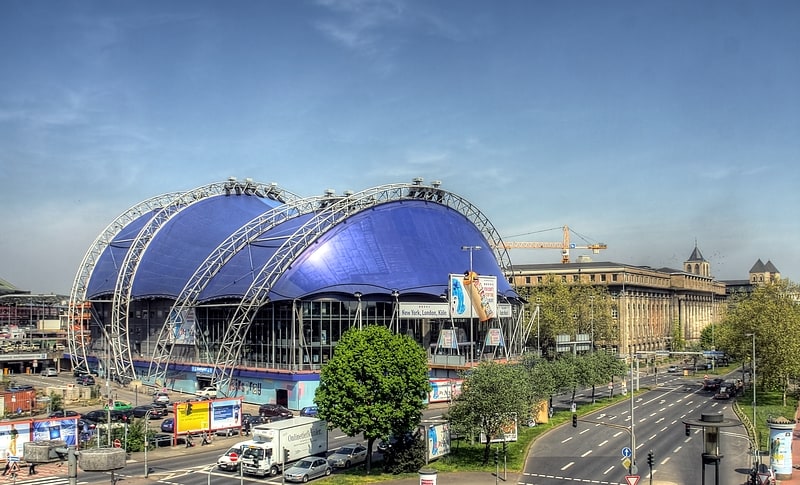
Theatre in Cologne, Germany. Musical Dome is a 1,640-seat theatre in Cologne, North Rhine-Westphalia, Germany. It opened in October 1996.[28]
Address: Goldgasse 1, 50668 Cologne (Innenstadt)
Colonius

Tower in Cologne, Germany. Colonius is the Cologne telecommunications tower, which was finished in 1981. The Colonius possesses a cafeteria, viewing platform, and a restaurant, apart from antennas for radio relay and radio services within the VHF range. Because of a missing leaseholder, the visitor's area including restaurant and viewing platform has been closed since 1992. At the time of its completion the Colonius was 252.9 meters high. In 2004 a radio tower added by helicopter increased the height to 266 meters. This addition allowed the broadcast of digital television from the tower in the Cologne/Bonn region.[29]
Address: Innere Kanalstr. 100, 50672 Köln (Innenstadt)
St. Maria ad Gradus

St. Maria ad Gradus is the name of a former church located East of the Cathedral of Cologne, Germany, situated between the cathedral and the Rhine.
Founded by Herman II, Archbishop of Cologne, the church was the burial site of blessed Richeza of Lotharingia (died March 1063), a former Queen of Poland and a grandchild of Otto II, Holy Roman Emperor and his wife Theophanu. The Romanesque building, 55m long and 42m wide, was probably completed by Archbishop Anno II in 1075, when the relics of St. Agilulfus of Cologne (died 750) were transferred there. Already in 1080 it burned down, but was rebuilt in 1085 and later expanded.
The remains of Richeza and others were later translated to the cathedral, which had been begun in 1248. Konrad von Hochstaden was canon of St. Maria ad Gradus and Archbishop of Cologne at this time, from 1238 to 1261.
Following the French occupation of the Rhineland in 1794, monasteries and religious foundations were dissolved, and churches abandoned. As St. Maria ad Gradus was too close to other churches (the Cathedral, Great St. Martin's, and St. Andreas), it was partially demolished in 1817; and most of what remained was removed in 1827 when the area was cleared to allow the Cathedral's restoration and completion. Only a few fragments remain.[30]
St. Maria im Kapitol
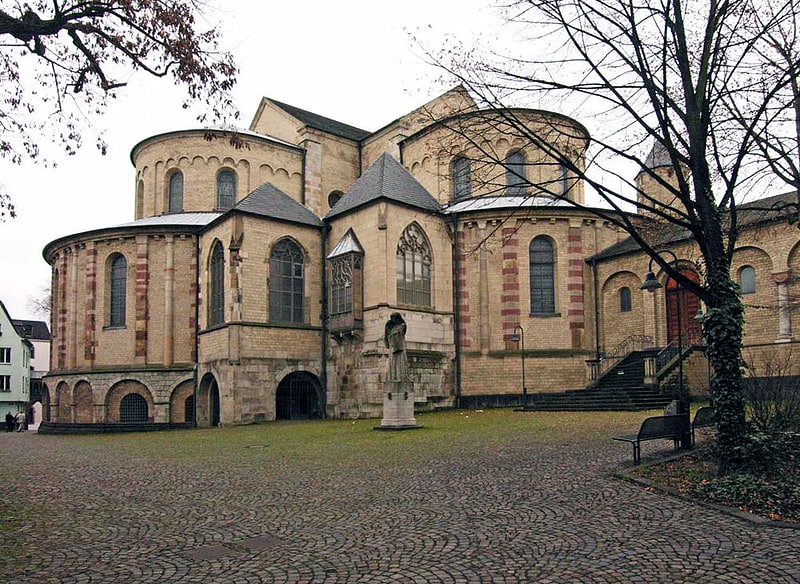
Romanesque church with medieval artwork. St. Maria im Kapitol is an 11th-century Romanesque church located in the Kapitol-Viertel in the old town of Cologne, Germany. The name “im Kapitol“ refers to the Roman temple for the Capitoline Triad that was built on today’s site of the church in the first century. The Catholic church is based on the Church of the Nativity in Bethlehem, was dedicated to St. Mary and built between 1040 and 1065. It is one of twelve Romanesque churches built in Cologne during this period.
Measuring 100 m x 40 m and encompassing 4,000 square metres of internal space, St. Maria is the largest of the Romanesque churches in Cologne. Like many of the latter, it has an east end which is trefoil in shape, with three apses. It has a nave and aisles and three towers to the west. It is considered the most important work of German church architecture of the Salian dynasty.[31]
Address: Kasinostraße 6, 50676 Köln (Innenstadt)
Köln Triangle
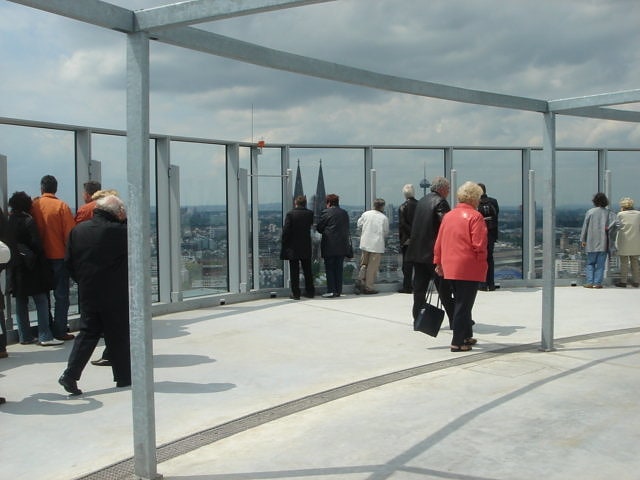
Also known as: Kölntriangle
Building in Cologne, Germany. KölnTriangle is a 103.2 metres tall building in Deutz, Cologne, and a prominent landmark in Cologne. The building was designed by Dörte Gatermann of Cologne-based architecture firm Gatermann + Schossig and completed in 2006. Its south facade consists of a double-facade, allowing natural ventilation even at high floors. Next to the high-rise structure, part of KölnTriangle is also a much larger six-story office block with a total gross floor area of 84,300 m2.
KölnTriangle is headquarters of the European Aviation Safety Agency (EASA). The top floor and roof houses a publicly accessible observation deck with panorama views all over Cologne, in particular Cologne Cathedral, directly opposite the Rhine.[32]
Address: Ottoplatz 1, 50679 Cologne (Innenstadt)
Mülheim Bridge

Also known as: Mülheimer Brücke
Suspension bridge in Cologne, Germany. The Mülheim Bridge in Cologne is a suspension bridge on the river Rhine in western Germany. It has a main span of 315 metres. The bridge was originally completed in 1929. On October 14–15, 1944, an American bomb struck the chamber containing the demolition charges, destroying the bridge. The bridge was rebuilt between 1949 and 1951. It connects the city district Riehl on the west side of the river with Mülheim on the east side, after which the bridge is named.[33]
Address: Mülheimer Ufer, Cologne (Mülheim)
St. George's Church
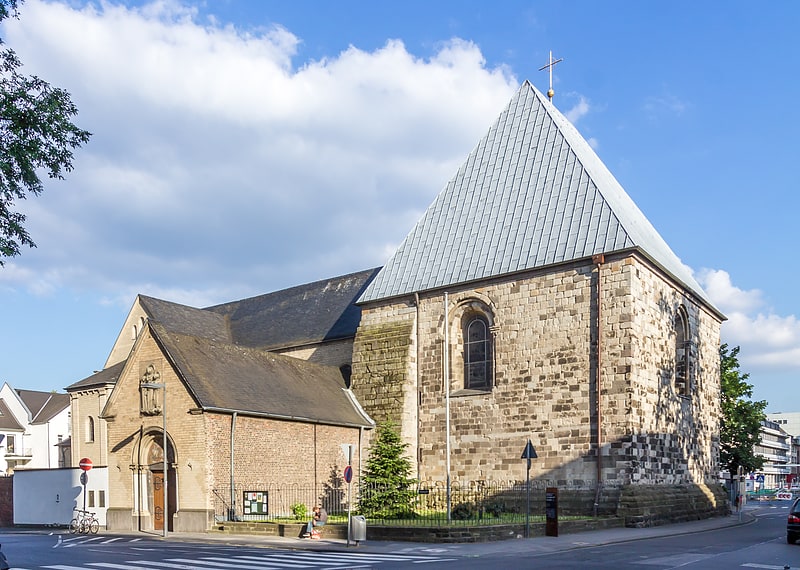
Also known as: St. Georg
Catholic church in Cologne, Germany. St. Georg's Church is one of twelve Romanesque churches in the city of Cologne, Germany.[34]
Address: Georgspl. 17, 50676 Köln (Innenstadt)
St Peter's Church

St Peter's Church is a Roman Catholic church in Cologne, run by the Jesuits. The painter Rubens was baptised in the church and his The Crucifixion of St Peter is on display there – it was commissioned in 1638 by the Cologne art collector and businessman Eberhard Jabach. The building also houses the 'Kunst-Station Sankt Peter', a centre for contemporary art, music and literature.[35]
Address: Leonhard-Tietz-Straße 6, Cologne (Innenstadt)